Unraveling the Nature of Knee Bursitis
Knee bursitis is a common condition characterized by inflammation of the bursae—small, fluid-filled sacs that serve as cushioning pads in the knee joint. These sacs help reduce friction between tissues such as bones, tendons, muscles, and skin, facilitating smooth joint movement. When these bursae become inflamed, individuals often experience pain, swelling, and limited mobility, which can significantly affect daily activities and quality of life.
What is Knee Bursitis?
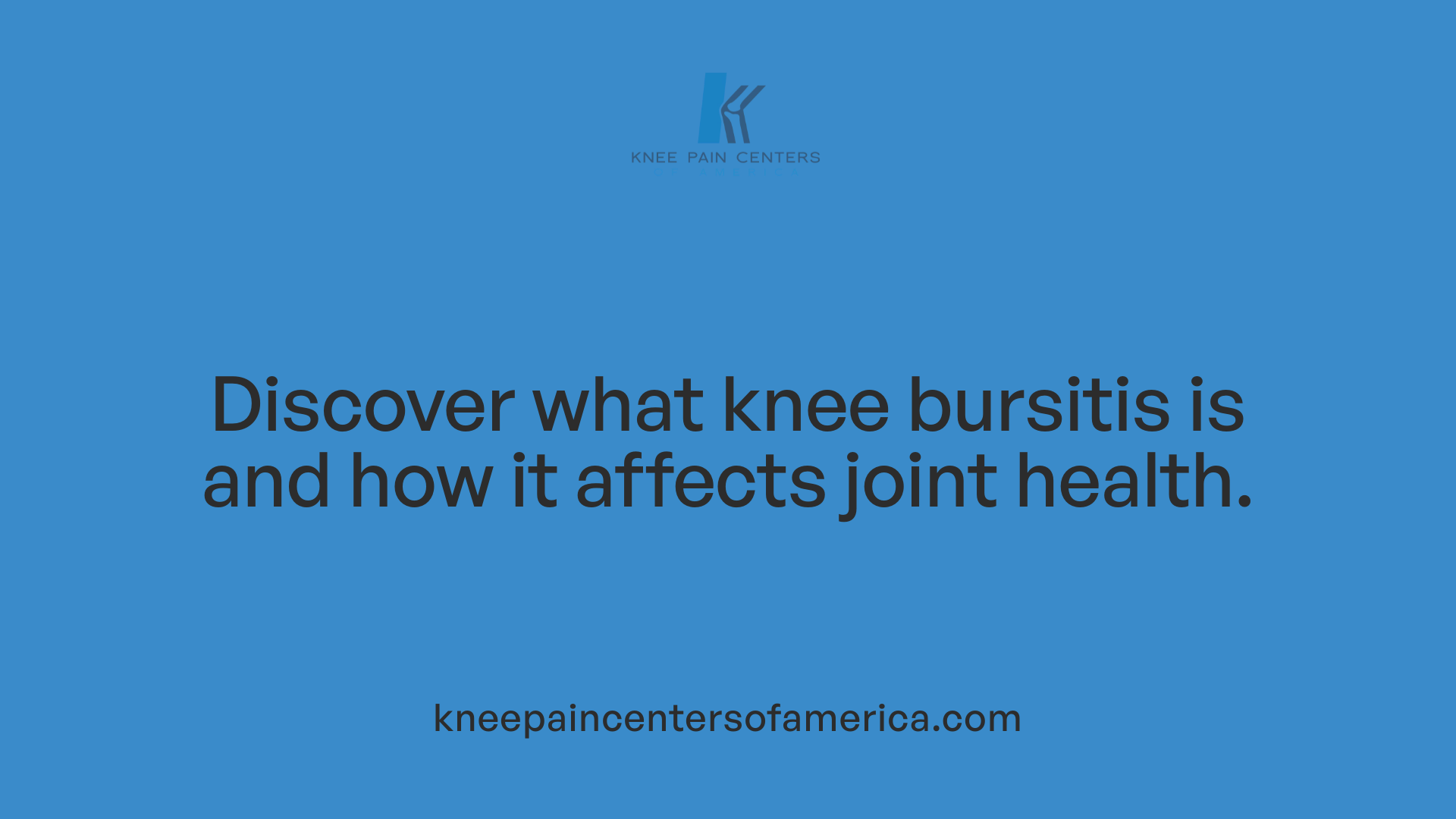
What is knee bursitis?
Knee bursitis is an inflammation of the bursae in the knee, which are small, fluid-filled sacs that serve as cushions to reduce friction between bones, tendons, muscles, and skin around the joint. These sacs enable smooth movement and protect tissues from rubbing against each other.
Among the various bursae in the knee, the most commonly affected is the prepatellar bursa, situated in front of the kneecap (patella). This condition, often called housemaid’s knee, results from repetitive kneeling, direct trauma, or infections. Another typical form is suprapatellar bursitis, which occurs above the kneecap.
Symptoms of knee bursitis usually include swelling, tenderness, warmth, and pain during movement or rest. Sometimes, a soft lump may be visible over the affected area. When infection is involved, redness, fever, chills, and a general feeling of illness can also occur. Diagnosis generally involves a physical examination and a review of medical history. To confirm the presence of infection or identify other underlying causes, imaging tests like X-ray, MRI, or ultrasound may be utilized. Additionally, fluid aspiration—drawing out fluid from the bursa with a needle—can help in diagnosis and treatment.
Treatment targets relieving symptoms and preventing complications. Common approaches include rest, icing, non-steroidal anti-inflammatory drugs (NSAIDs), and activity modification. In cases where fluid buildup is significant, aspiration may be performed to remove excess fluid. Corticosteroid injections can also help reduce inflammation. If an infection is diagnosed, antibiotics are administered promptly. For persistent or severe bursitis, surgical options such as bursa removal or drainage might be considered; however, these are relatively rare.
In summary, knee bursitis stems from various causes, including overuse, injury, or infection, and manifests through swelling and pain. Proper diagnosis and treatment usually lead to a full recovery, especially when managed early.
Recognizing the Symptoms of Knee Bursitis
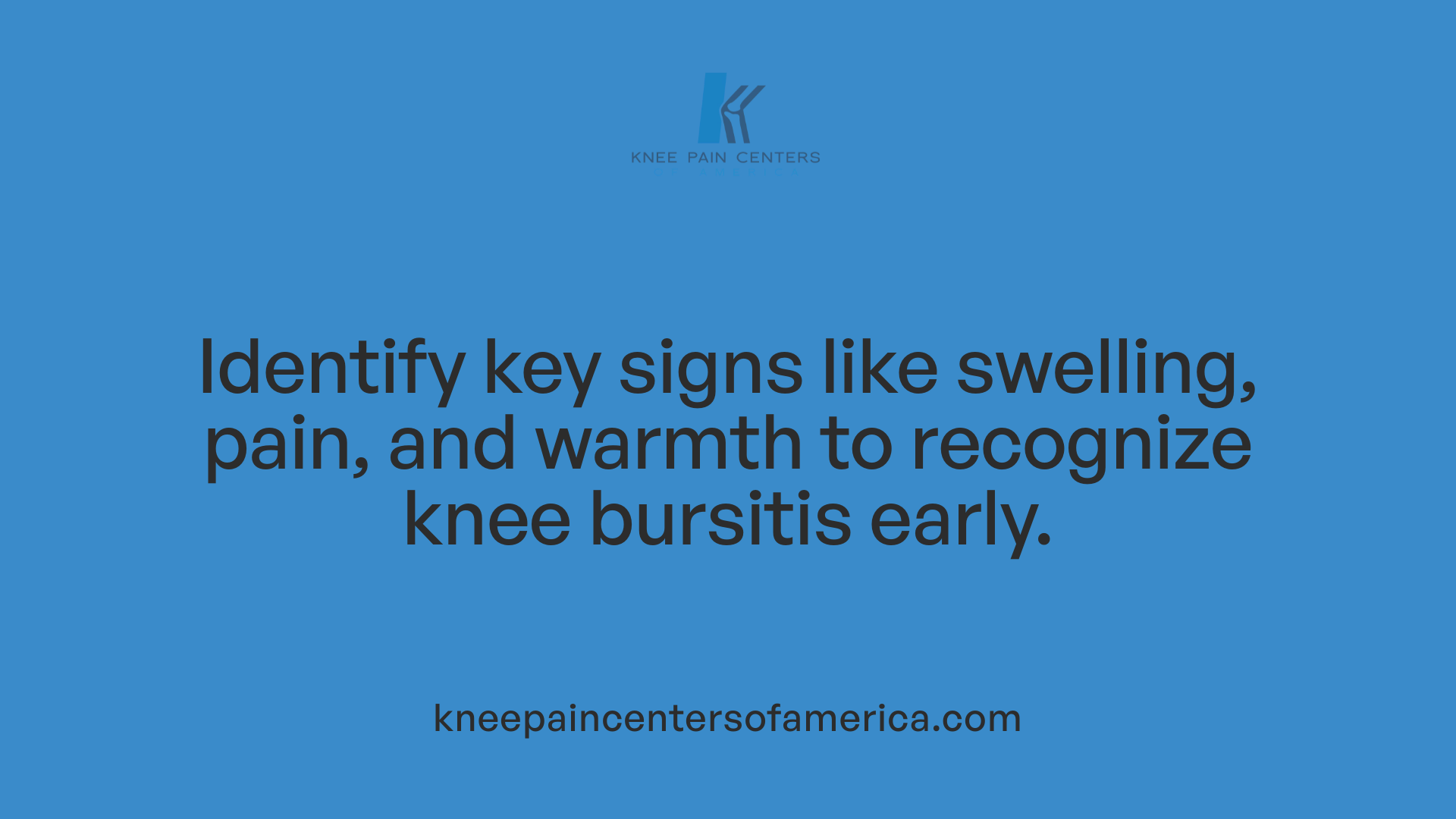
What are the symptoms of knee bursitis?
Knee bursitis manifests with a variety of signs that reflect inflammation of the bursae—small fluid-filled sacs that cushion the knee joint. Most commonly, individuals will notice pain in the affected area, which can be mild or severe, especially during movement or when pressure is applied.
Swelling is a prevalent symptom, often resulting in a visible, soft, and sometimes squishy lump over the front of the knee. This swelling occurs due to excess fluid accumulation within the inflamed bursa. The affected knee may also feel tender to the touch, with increased sensitivity around the inflamed area.
Warmth and redness are typical in septic bursitis, which involves an infection within the bursa. These signs indicate active inflammation and sometimes systemic responses like fever and chills, especially if the infection is severe.
Movement limitations are common because pain and swelling restrict the natural range of motion. Patients might experience difficulty straightening or bending the knee, which can interfere with daily activities.
The onset of symptoms can vary—some develop symptoms quickly following an injury or repetitive use, while others may notice a gradual increase in discomfort and swelling over time due to ongoing friction or pressure, such as prolonged kneeling.
In cases where infection causes bursitis, additional symptoms include skin discoloration, warmth to touch, and possibly discharge if sores develop. Fever and chills are more serious signs indicating that the infection might be spreading.
Overall, knee bursitis symptoms often include acuity presenting as achiness, stiffness, and a rubbing or throbbing sensation at the inflamed site. Continued activity can exacerbate pain, making it essential to recognize these signs early for effective management.
How do signs of septic bursitis differ from other types?
Septic bursitis entails an infectious process and is distinguished by its additional signs. Unlike non-infectious bursitis, which primarily involves swelling, tenderness, and pain, septic bursitis usually presents with prominent redness, warmth, and skin discoloration. Patients often experience systemic symptoms like fever, fatigue, and chills.
In septic bursitis, the affected bursa may become more tender, swollen, and appear inflamed rapidly after minor trauma or overuse. Sometimes, there may be visible skin rashes or sores, and pus might be evident if the bursa is opened or drained. The presence of these signs indicates that immediate medical treatment is necessary to prevent the spread of infection.
In summary, while all bursitis involves swelling and discomfort, the signs of septic bursitis include more pronounced redness, warmth, system-wide symptoms such as fever, and the potential for discharge, marking it as a medical emergency that requires prompt intervention.
How Is Knee Bursitis Diagnosed?
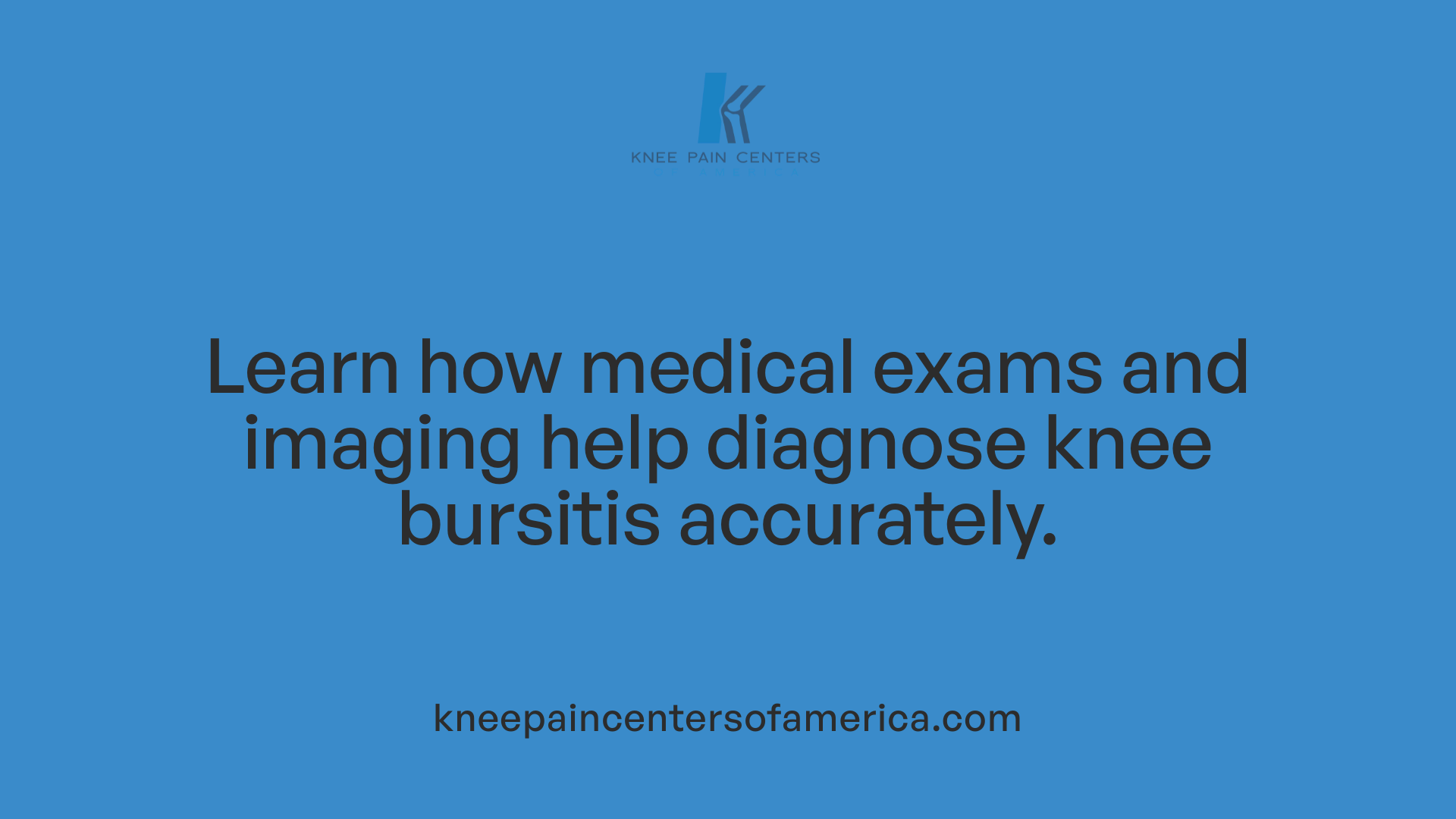
How is knee bursitis diagnosed?
Knee bursitis is diagnosed through a combination of clinical examination procedures and imaging or fluid analysis. Initially, a healthcare provider conducts a thorough physical examination to evaluate signs such as swelling, tenderness, warmth, redness, and any limited movement around the knee joint. The doctor also assesses for pain during movement, at rest, and when pressing on the affected area. During the exam, the skin is inspected for any signs of infection or skin changes.
Gathering a detailed medical history is equally important. The patient’s activity patterns, recent injuries, occupational habits like frequent kneeling, or underlying medical conditions such as gout or rheumatoid arthritis are reviewed to help guide diagnosis.
To rule out other potential causes of knee pain, imaging tests are often employed. X-rays are useful to exclude bone fractures, osteoarthritis, or other bone-related issues. However, since bursitis involves soft tissue inflammation, ultrasound and magnetic resonance imaging (MRI) are more effective for visualizing the inflamed bursae, surrounding tissues, and detecting any fluid accumulation.
In cases where infection or gout is suspected, fluid aspiration—also known as joint or bursal fluid analysis—is performed. Using a thin needle, a sample of the fluid from the bursa is drawn out and sent for laboratory testing. This fluid analysis can identify bacteria (indicating septic bursitis), crystals from gout, or inflammatory cells, providing valuable information for accurate diagnosis.
By integrating clinical examination findings with imaging studies and fluid analysis, healthcare providers can accurately diagnose knee bursitis. This comprehensive approach not only confirms the presence of bursitis but also helps differentiate it from other conditions affecting the knee, ensuring appropriate treatment are given.
Treatment Strategies for Knee Bursitis
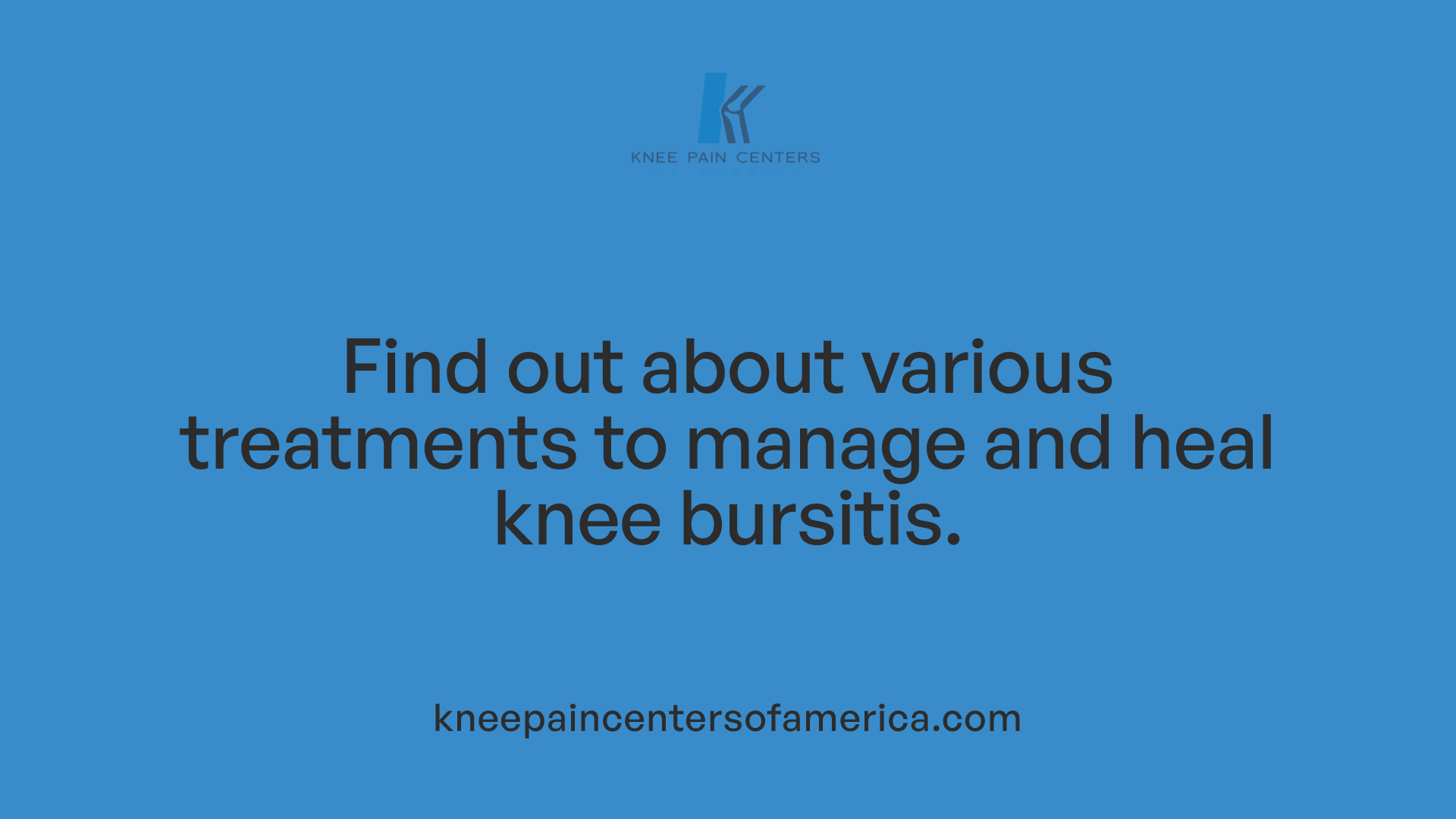
What are the treatment options for knee bursitis?
Managing knee bursitis effectively depends on the severity and underlying cause of the condition. Initial approaches usually involve conservative treatments aimed at reducing inflammation, alleviating pain, and preventing further irritation.
Conservative treatments are the first line of defense. These include rest—avoiding activities that exacerbate symptoms like kneeling or repetitive bending—combined with ice application to reduce swelling and inflammation. Applying ice for 15-20 minutes several times a day helps to numb the area and minimize inflammation. Compression, such as wearing a knee brace or elastic bandage, supports the joint and decreases swelling. Elevating the knee above heart level also aids in fluid drainage and further reduces swelling.
Pain relievers like over-the-counter medications such as ibuprofen or acetaminophen can be effective in managing discomfort. These medications address both pain and inflammation, making daily activities easier.
For persistent or more severe cases, medical interventions are often employed. Corticosteroid injections are common to quickly reduce inflammation and provide relief. These injections deliver anti-inflammatory medication directly into the bursa, which can significantly decrease swelling and pain. However, repeated injections may weaken the bursa tissue and are used judiciously.
If infection is suspected—indicated by redness, warmth, fever, or chills—antibiotics become necessary. In some cases, aspirating fluid from the bursa with a needle not only collects a sample for analysis but also relieves pressure and reduces pain. This procedure, called aspiration, can also guide appropriate treatment if bacteria are present.
For cases that do not respond to non-surgical measures or when bursitis recurs frequently, surgical options may be considered. Bursectomy involves the removal of the inflamed bursa and can be performed traditionally or through minimally invasive arthroscopic techniques. Surgery is typically a last resort and is reserved for severe or chronic bursitis.
In addition to direct treatments, physical therapy plays a vital role in recovery. A physical therapist can develop a tailored exercise program to strengthen surrounding muscles, improve joint stability, and prevent future episodes. Activity modifications—like avoiding prolonged kneeling or pressure on the knee—are also critical components of treatment.
Emerging regenerative therapies, such as platelet-rich plasma (PRP) or stem cell injections, are gaining attention as potential options to promote natural healing of damaged tissues, possibly reducing the need for surgery. These treatments aim to harness the body’s own regenerative capabilities to restore healthy tissue.
In summary, treatment strategies for knee bursitis encompass a range of options—from conservative measures and medications to injections and surgery—each selected based on individual patient needs and disease severity. Proper diagnosis and tailored treatment plans can significantly improve outcomes and prevent recurrence.
Prevention and Recovery Tips for Knee Bursitis
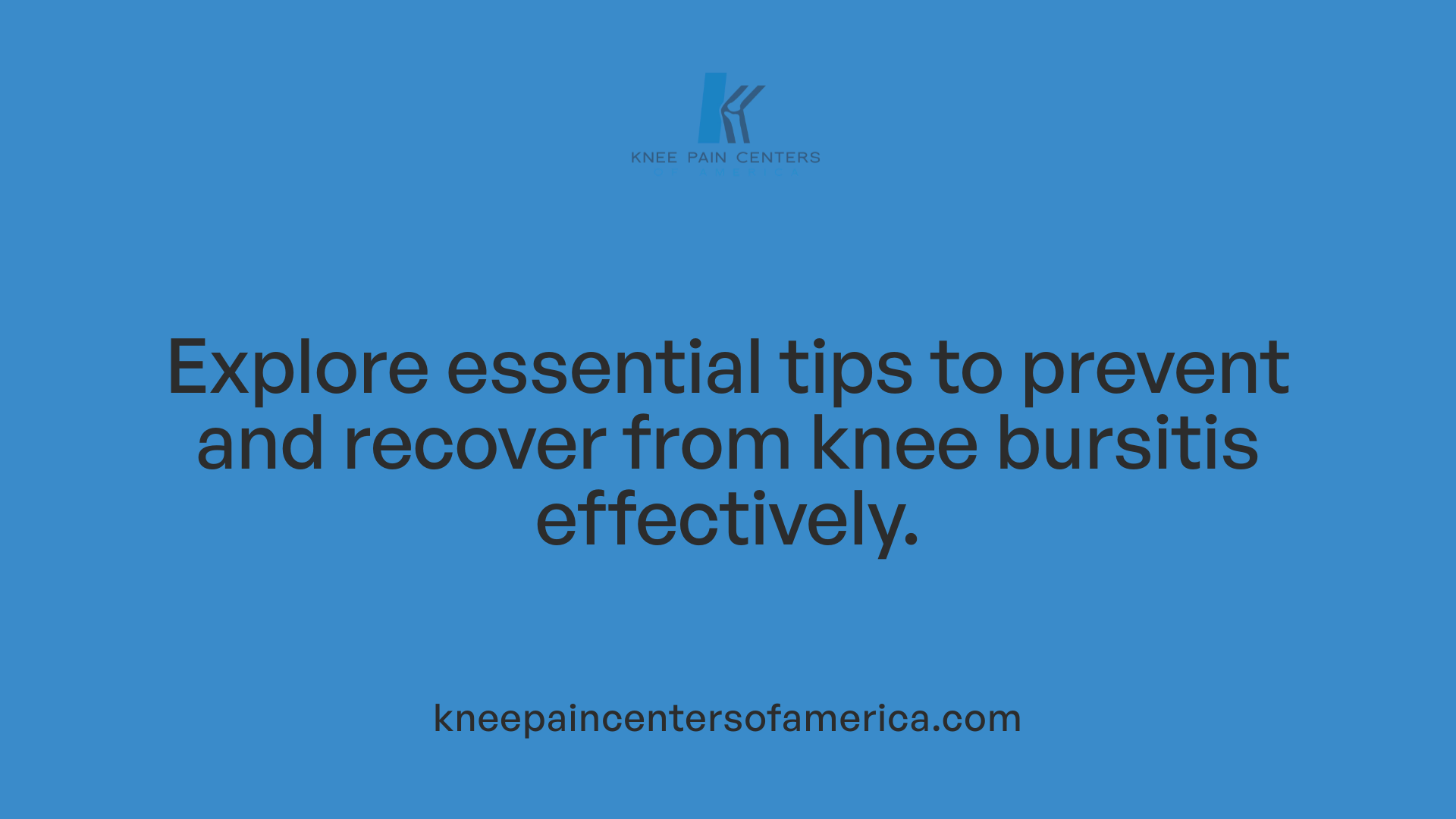
How can knee bursitis be prevented?
Knee bursitis can often be avoided through simple lifestyle and activity modifications. It is important to steer clear of prolonged kneeling and repetitive pressure on the knees, especially on hard surfaces. Using knee pads or cushioning while kneeling provides a protective barrier that can significantly reduce stress on the bursae.
Maintaining a healthy weight is vital, as excess weight puts additional pressure on the knee joint, increasing the likelihood of friction and inflammation. Regularly engaging in strength and flexibility exercises for the thigh and knee muscles helps shield the bursae from strain caused by overuse or sudden movements.
Proper warm-up routines before physical activity and gradually increasing activity intensity are crucial in preventing strain injuries. During active tasks or sports, taking frequent breaks and wearing appropriate footwear can further lessen the risk. These preventive practices create a protective environment around your knees, helping to avert inflammation and bursitis.
What are management and recovery tips for knee bursitis?
Treating knee bursitis effectively involves a combination of medical guidance and self-care strategies aimed at reducing symptoms and promoting healing. Follow your healthcare provider’s recommendations, which may include medications such as antibiotics if an infection is present or corticosteroids to lessen inflammation.
Avoid activities or positions that aggravate the pain, especially repetitive kneeling or pressure on the affected knee. Using ice packs on the knee for 15-20 minutes several times a day helps control swelling and soothe discomfort. Elevating the leg above heart level additionally encourages fluid drainage and reduces swelling.
Physical therapy can play a significant role in recovery by strengthening the muscles around the knee, improving flexibility, and restoring mobility. Supportive measures like knee braces or pads can prevent further irritation during activity.
Over-the-counter pain relievers like NSAIDs (ibuprofen or naproxen) are effective for relieving pain and inflammation. Maintaining a healthy weight decreases the overall load on the knee, aiding faster recovery.
If symptoms persist beyond a few weeks or worsen despite home treatment, consult a healthcare professional. Additional interventions such as fluid aspiration, tailored physical therapy, or, in severe cases, surgical removal of the inflamed bursa may be necessary to achieve full recovery.
Proactive management and adherence to recommended practices can ensure a quicker return to normal activity and reduce the risk of recurrent bursitis.
Maintaining Knee Health
Knee bursitis, while painful and disruptive, is often manageable with early diagnosis and appropriate treatment strategies. Preventative measures like avoiding prolonged kneeling, maintaining a healthy weight, and strengthening knee-supporting muscles can significantly reduce risk. When symptoms do occur, resting the joint, applying ice, and consulting healthcare providers for personalized treatment—including medications, injections, or even surgery—can lead to full recovery. Staying proactive about knee health and addressing issues promptly ensures that individuals can return to their daily routines with minimal discomfort and long-term complications.
References